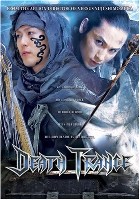
Unrepentant in its willingness to peel back the fragile skin of cultural taboo with fingers (and blades) dipped as deeply in blood as they are in tantalizing taboos of culture, Asian cinema celebrates perversion, sexuality, and the art of violence in a glorified, undeniably excessive manner. The celluloid terrors of this culture are perhaps even more graphic (and brutally honest!) than the heyday of European horror (1970's-80's), when we thought maggot rainstorms, barfing entrails, and brain-ripping were the last words in fetishistic violence. It wasn't, not by a long shot. Asian horror in its more extreme graphic psychological incarnations (as opposed to its suggestive supernatural counterparts) is a rough, rowdy, unrepentant punch in the guts, a revelation to viewers used to the oh-so-sanitized banality of modern remakes and fearless freak-fests churned out by studios whose closest brush with fear are special interest groups.
Death Trance, following in the torrid tradition of such recent kung-fu blood-sports as Versus, is a refreshingly brazen, lyrical, and energetic explosion of slashing swordsmanship, gore, and action. This feverish adventure is as daring in its amoral, cosmic plot as it is brutally beautiful in its splashy depictions of violence. Death Trance shares obvious similarities of theme and atmosphere to the compelling Lone Wolf and Cub series of Samurai legend. Influenced by those films ballets of blood, this mystical marriage of harsh realism and Eastern mysticism is also indebted to that series for its dream-like atmosphere, fragmented structure (a format where shifts in time and perspective mirror both the enigmatic turnings of the plot as well as its character's conflicted emotional states), and grimness. More importantly, the movie manages to fuse these elements into something unique.
Starring Tak Sakaguchi of Versus, and directed by Yuji Shimomura, Death Trance tells a story of eternal reoccurrence across a mysterious un-named arena of good, evil, and the amoral powers that fight for balance between both extremes. In an unknown place and period, Grave (Tak Sakaguchi), a master Samurai with the abandon of a child and worldview attracted to chaos, searches his shadowy world of betrayal and death for the ultimate battle. Stealing a legend-haunted coffin from the holy Tougan Temple, his world of extremes is further complicated when a young girl follows him from the temple grounds, a willing spectator to his battles with men and immortals. A race without a winner, the archetypal forces of good and evil race to regain the coffin from Grave, who fights both with unceasing hunger, remarkable in his fury. In an outlandish war between gods and men, myths and heroes, a nightmare world of dream-logic, isolation, and visually stunning decadence mirrors the fury of a warrior whose spirit belongs to the pleasures of the fight.
Death Trance joyfully celebrates excessive violence and the mangling of social taboos. This story also indulges in such hands-off themes as sado-masochism and torture, crafting an emotional atmosphere of amorality where the only saving faith is a deadly steel point and a strong arm to wield it. Whereas other films of this ilk would be satisfied to titillate, wallowing in over-the-top carnality and high-kick heroics, this flick also emphasizes the importance of plot, finding depth to support its flashy theatrics in the black hearts of its disturbingly enigmatic anti-hero. With its introspective sub-text and careful handling of atmosphere, the director dissects themes of identity, blame, and generational warfare that are just as disturbing as the exquisitely filmed moments of grand guignol.
In these films how the action is orchestrated is often more important than the events themselves. Roaring with a rabid, feverish intensity, Death Trance is no slouch in this category. While the mechanics of the plot, and emotional if ambiguous personalities of its broadly developed characters, are certainly involving, creating a layer of emotional interest to this decadent dance-of-death, the movie is devoted to physical spectacle and the poetics of adrenaline. As such it must be judged by its ability to deliver action that not only entertains but awes. It does so with savage grace. The very act of conflict becomes a character, sporting its own psychological politics and poetry, rituals and ramifications.
A modern myth of blood-sport, symbolic characters, and non-logical progression, Death Trance suggests a world without justification or clean-cut reasoning. The nameless world the characters inhabit could easily be anywhere at anytime, lending to the effect pf isolation and disorientation. Not knowing where we are, it's that much easier to accept the ambiguities of the plot. In fact, they are not important, for this is a cosmic fable, a larger-than-life fantastical reflection of Other-worldy significance. The battles may be seen as archetypal embodiments of universal conflict, while the realistic blood-shed grounds the more ethereal elements in a naturalistic context. Taking a backseat to stylistic acrobatics, the plot is barely existent. Whereas this would cripple a story of sequential narrative logic, it only adds to the delirious intensity of Death Trance.
Remastered and offered in 1:78.1 anamorphic widescreen, Death Trance looks absolutely stunning. A mythic orchestra of colors, sights, and sounds, the film's look is a hybrid of oriental fable and adult faire. Strong robust colors coat the action with an unearthly presence. Audio is presented in both Japanese 5.1 Surround Sound and Stereo and English 5.1 Surround Sound and 2.0. English optional subtitles are also included. Extras, while hardly exhaustive, are worthwhile. Included are "The Making of Death Trance," by far the most in-depth offering, exploring the process and underlying beliefs behind the feature, and the original theatrical trailer. These are followed by a rather funny interview with Tak Sakaguchi and trailers for Shadow: Dead Riot, The Great Yoki War, Izo, and One Missed Call (2).
Review by William P. Simmons
| Released by Tokyo Shock |
| Region 1 NTSC |
| Not Rated |
| Extras : see main review |